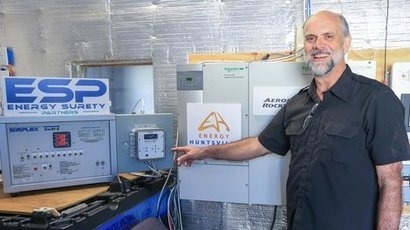
Reducing demand peaks on the electrical supply grid can help save money for utilities and consumers. The prototype Charger Energy Lab has been developed by Dr. Bill Carswell, a UAH Research Institute principal research scientist, with the help of two doctoral students, to demonstrate this. According to Dr Carswell, if the technology was scaled up, it would result in smaller peak grid stress and help power companies better manage the costs of designing grids sized to handle peaks that can be many times average use.
Dr Carswell’s studies show that in the Charger Energy Lab, the cost savings paid for the investment in batteries and other equipment in only 3½ years. The lab uses computer monitoring along with a smart electric meter to calculate when there are peak electricity usage times. At peaks, the system automatically switches the building off the electrical grid and onto power supplied by a battery pack in the building. The batteries are in turn recharged from the grid in off-peak hours and also through the use of solar cells located outside. The building also a diesel backup generator, so it is self-sufficient during power outages. A future natural gas-fuelled generator is planned to ensure an ever-present fuel source.
“On a cold winter morning, when all the businesses open and residents wake up and turn on the heat, the drain on the power grid can be enormous” said Dr. Carswell. “Most of us recall extremely cold ‘polar vortex’ mornings when the stress on the power grid actually caused power outages. Likewise, on a hot summer afternoon when all the air conditioners in town are running full blast, this can cause power outages. These peak demand periods of use keep TVA and Huntsville Utilities managers up at night worrying about how to make sure their customers don’t lose power.”
Dr Carswell added that when a peak demand is reached on a cold winter morning or a hot summer afternoon, the building can become an energy island. It uses its own power for the high demand hours so that it doesn’t put stress on the power grid. If lots of residents and businesses were to do this, it would greatly improve the ability of power companies to provide continuous power during times of high system stress.
Because high stress is dangerous to the grid, power companies charge some customers more when they use a lot of power all at once, like for heat and cooling. Utilities must charge the fee to help them pay for the equipment needed to make sure the grid doesn’t collapse under high demand, without charging extra to the average resident. This peak demand fee can be a surprisingly large part of a power bill.
“When you use the technology developed in the Charger Energy Lab, you do two things: you avoid stressing the grid on cold mornings and hot afternoons and you save yourself money by not paying that peak demand fee” Dr Carswell said. “You can’t separate yourself from the grid when you are using large amounts of power unless you know, real-time, when you are using large amounts of power. Huntsville Utilities is currently field-testing a new smart meter technology to get it ready for general use. It’s called Advanced Metering Infrastructure (AMI) and you will soon be hearing a lot more about it. It’s really going to change our lives as consumers, helping us save energy, save money and create a more resilient community.”
Dr. Carswell is currently building a team with the goal of creating a proposed larger, commercial-scale demonstration of the technology at the US Space and Rocket Centre. The proposed project is geared to the introduction of AMI locally. UAH see this as a community demonstration project so that when the AMI program is in full operation, anyone in Huntsville can come see it and go back to a home or business and do the same thing. This will make Huntsville a much more vibrant and resilient community, where users of energy have more control over how and when they use power from the grid and how much they pay. It will also improve the community’s ability to withstand and recover from natural disasters. That’s because an added benefit of automatically isolating a home or business as an energy island is that it becomes self-sufficient in a natural or man-made disaster.
If communities have this ability to become their own energy island, then if the power does go out for any reason, they can separate themselves from the grid and continue to use electricity as normal. This is safe and convenient. Then when the power comes back on they can connect back to the grid and re-charge the batteries. If the power is out for a long time, like during the 2011 tornadoes, then they can use solar power and generators to re-charge the batteries until the grid power is restored.
Research and development at the Charger Energy Lab prototype has drawn together UAH students, members of the Huntsville business community and area governmental organizations.
UAH students involved in the lab are Industrial & Systems Engineering and Engineering Management (ISEEM) doctoral students Jeff Dyas and Anyama Tettey, who were sponsored by the National Science Foundation to work as lab research assistants under ISEEM Director Dr. Paul Collopy, and undergraduate students Karthik Sola in Electrical Engineering and Cathy Gibbs in Computer Science.
Aerojet Rocketdyne Power Innovations, Johnson Controls Inc., Avion Energy Solutions, Energy Surety Partners and OSIsoft LLC have supported the project by donating time and equipment. The project has also received support from Huntsville Utilities, the US Army Aviation and Missile Research Development and Engineering Center (AMRDEC), and the UAH facilities team.
Image: Dr. Bill Carswell points out monitoring equipment located atop the battery pack in the Charger Energy Lab (Michael Mercier, UAH)
For additional information:

